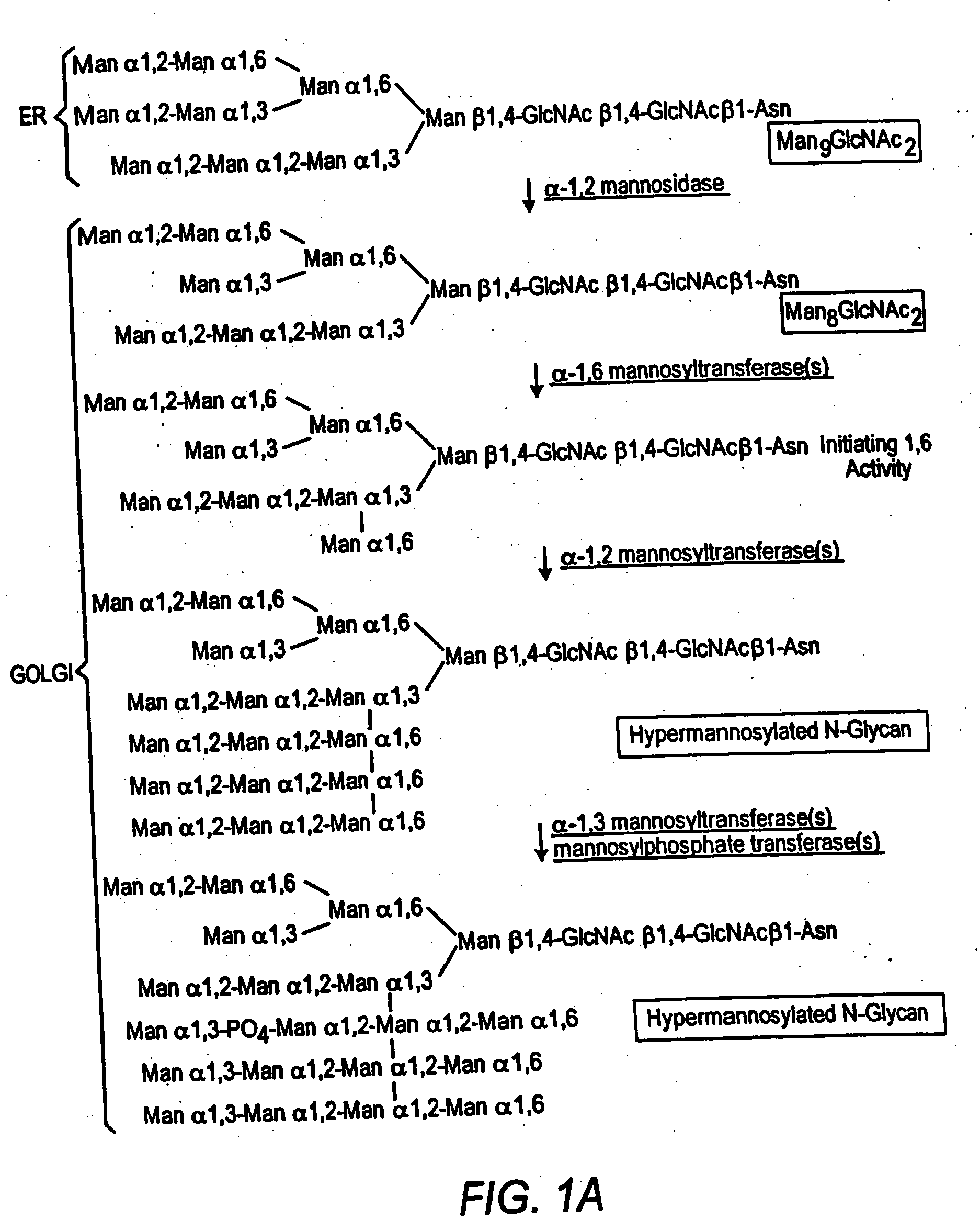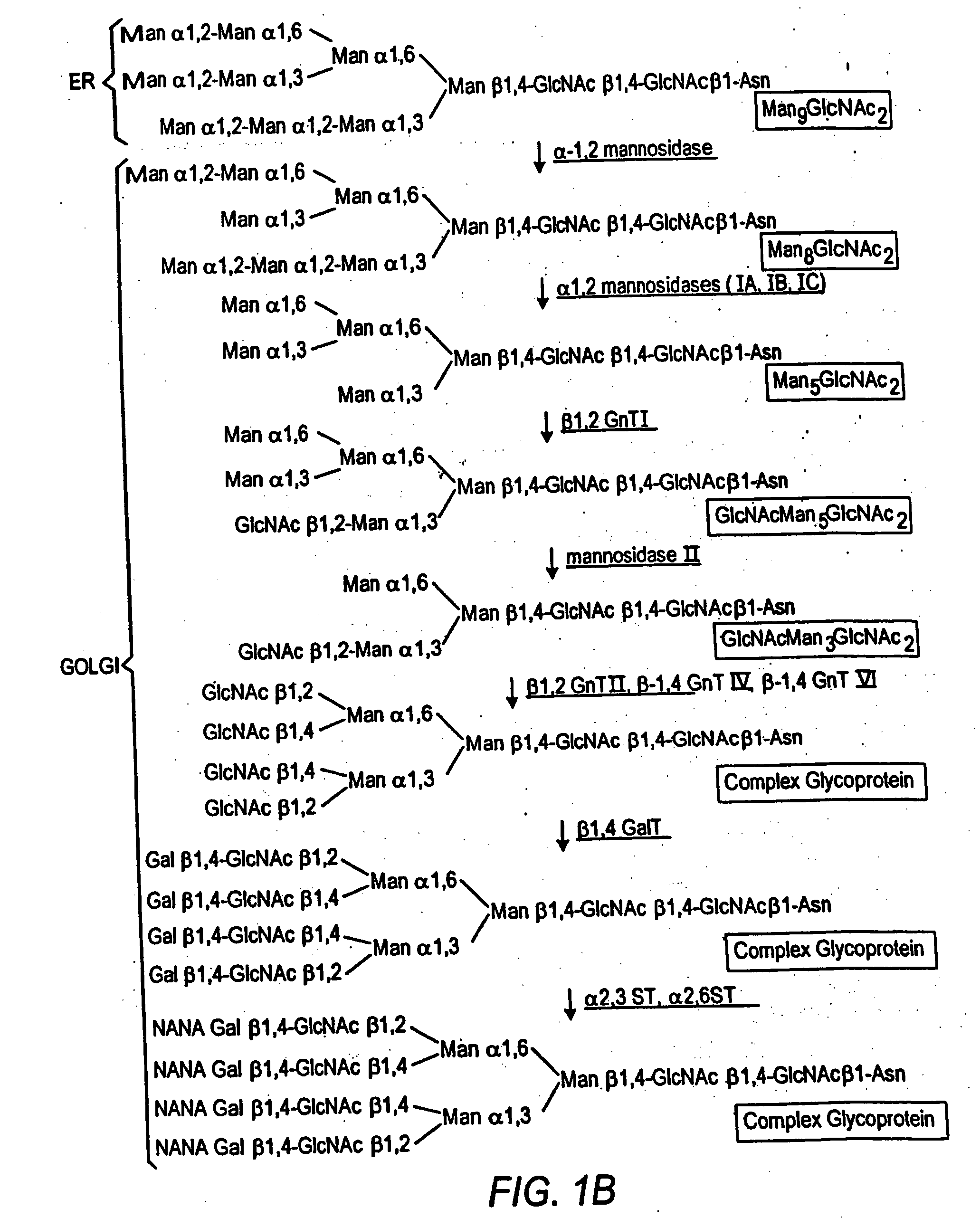Methods for producing modified glycoproteins
a technology of modified glycoproteins and glycoproteins, which is applied in the direction of drug compositions, metabolic disorders, immune disorders, etc., can solve the problems of reducing therapeutic efficiency, preventing proper functioning of enzymes, and udp-glcnac in the host organism, so as to improve the efficiency of engineered glycosylation steps, reduce competitive product inhibition, and promote the removal of nucleoside diphosphates
- Summary
- Abstract
- Description
- Claims
- Application Information
AI Technical Summary
Benefits of technology
Problems solved by technology
Method used
Image
Examples
example 1
Engineering of P. pastoris with α-1,2-Mannosidase to Produce Interferon
[0088] An α-1,2-mannosidase is required for the trimming of Man8GlcNAc2 to yield Man5GlcNAc2, an essential intermediate for complex N-glycan formation. An OCH1 mutant of P. pastoris is engineered to express secreted human interferon-β under the control of an aox promoter. A DNA library is constructed by the in-frame ligation of the catalytic domain of human mannosidase IB (an α-1,2-mannosidase) with a sub-library including sequences encoding early Golgi localization peptides. The DNA library is then transformed into the host organism, resulting in a genetically mixed population wherein individual transformants each express interferon-β as well as a synthetic mannosidase gene from the library. Individual transformant colonies are cultured and the production of interferon is induced by addition of methanol. Under these conditions, over 90% of the secreted protein includes interferon-β. Supernatants are purified to...
example 2
Engineering of Strain to Express GlcNAc Transferase I
[0089] GlcNAc Transferase I activity is required for the maturation of complex N-glycans. Man5GlcNAc2 may only be trimmed by mannosidase II, a necessary step in the formation of human glycoforms, after the addition of GlcNAc to the terminal α-1,3 mannose residue by GlcNAc Transferase I (Schachter, 1991 Glycobiology 1(5):453-461). Accordingly a library is prepared including DNA fragments encoding suitably targeted GlcNAc Transferase I genes. The host organism is a strain, e.g. a yeast, that is deficient in hypermannosylation (e.g. an OCH1 mutant), provides the substrate UDP-GlcNAc in the Golgi and / or ER, and provides N-glycans of the structure Man5GlcNAc2 in the Golgi and / or ER. After transformation of the host with the DNA library, the transformants are screened for those having the highest concentration of terminal GlcNAc on the cell surface, or alternatively secrete the protein having the highest terminal GlcNAc content. Such a...
example 3
Engineering of Strains with a Mannosidase II
[0090] In another example, it is desirable in order to generate a human glycoform in a microorganism to remove the two remaining terminal mannoses from the structure GlcNAcMan5GlcNAc2 by action of a mannosidase II. A DNA library including sequences encoding cis and medial Golgi localization signals is fused in-frame to a library encoding mannosidase II catalytic domains. The host organism is a strain, e.g. a yeast, that is deficient in hypermannosylation (e.g. an OCH1 mutant) and provides N-glycans having the structure GlcNAcMan5GlcNAc2 in the Golgi and / or ER. After transformation, organisms having the desired glycosylation phenotype are selected. An in vitro assay is used in one method. The desired structure GlcNAcMan3GlcNAc2 (but not the undesired GlcNAcMan5GlcNAc2) is a substrate for the enzyme GlcNAc Transferase II. Accordingly, single colonies may be assayed using this enzyme in vitro in the presence of the substrate, UDP-GlcNAc. The...
PUM
 Login to View More
Login to View More Abstract
Description
Claims
Application Information
 Login to View More
Login to View More - R&D
- Intellectual Property
- Life Sciences
- Materials
- Tech Scout
- Unparalleled Data Quality
- Higher Quality Content
- 60% Fewer Hallucinations
Browse by: Latest US Patents, China's latest patents, Technical Efficacy Thesaurus, Application Domain, Technology Topic, Popular Technical Reports.
© 2025 PatSnap. All rights reserved.Legal|Privacy policy|Modern Slavery Act Transparency Statement|Sitemap|About US| Contact US: help@patsnap.com


